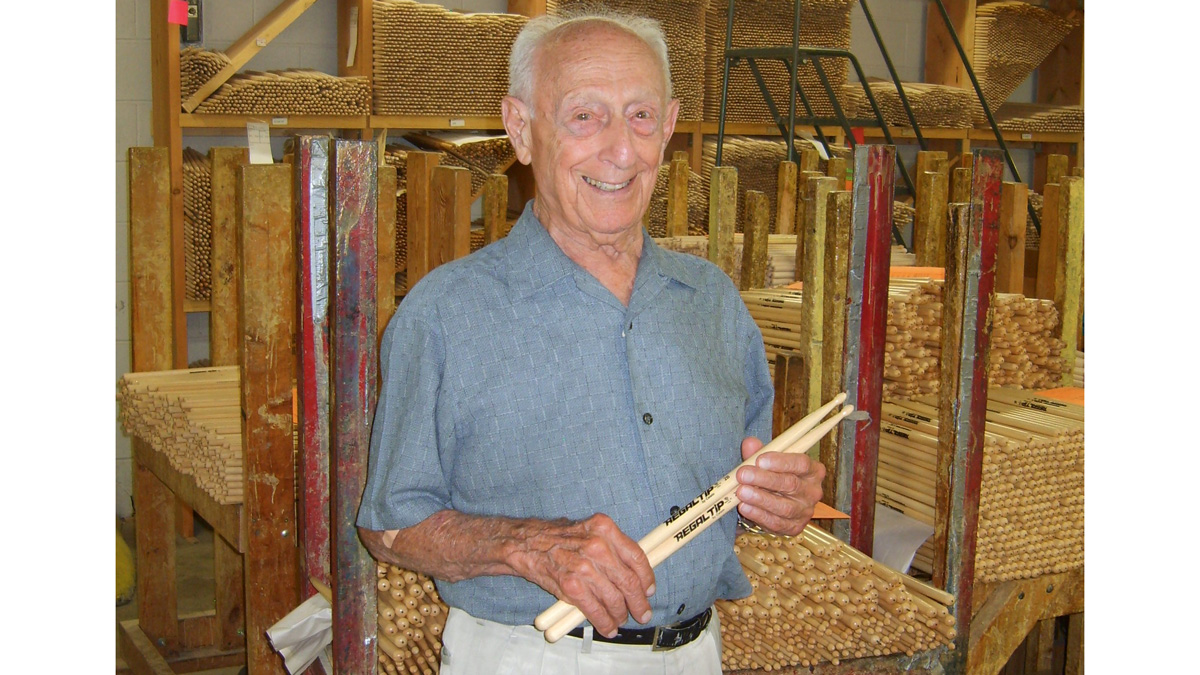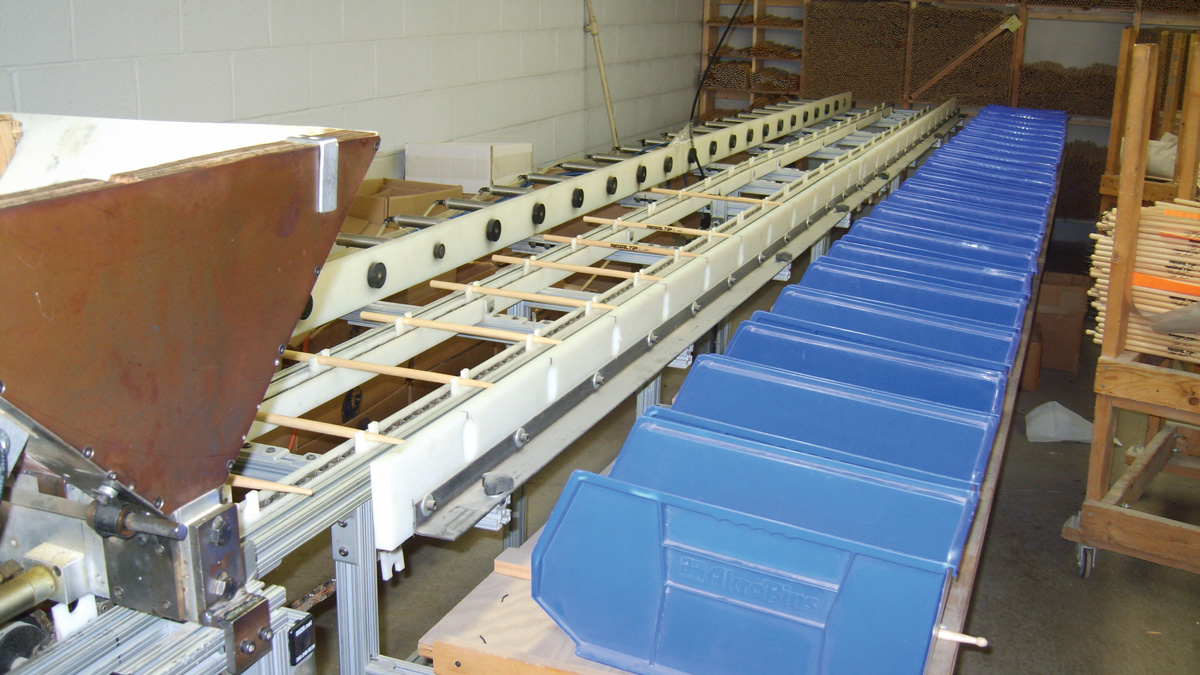Joe Calato talks Regal Tip past, present and future
At 95, veteran who invented nylon tipped drum sticks looks back - and forward

The quiet pioneer
At the age of 95, Joe Calato is quiet and unassuming.
From his demeanour, you might never take him for what he also is: an innovator who can rightly stand among the pioneers of the percussion industry. For it was this quiet, unassuming man - himself a lifelong drummer - who revolutionised drum stick design by inventing the nylon tip. And while he was doing that, Joe also established the first major independent drum stick company.
Joe grew up in Niagara Falls, New York. His father played drums, and Joe took up the instrument at the age of eight. When he was 13, the American Congress repealed the prohibition of alcohol that had been in place since 1920. This gave Joe an opportunity.
“After prohibition was repealed, a lot of saloons came along,” says Joe. “And they all wanted music. So I was playing and making money. I never wanted to be a great drumming technician; I just wanted to play music and keep good time. And I’ve been doing it ever since.”
Ever since, that is, except for a two-year stint in the US Army Air Corp during World War II, when Joe flew combat missions as a navigator in a B-17 Flying Fortress. “When the war in Europe ended I was sent back to the States to train on B-29s for the war in the Pacific. But that ended while I was home on furlough. So I came back to Niagara Falls and started playing again.”
I never wanted to be a great drumming technician; I just wanted to play music and keep good time. And I’ve been doing it ever since.
In the late 1940s there were no drum stick companies. Sticks were made and sold by the drum companies... almost as an afterthought. “Those sticks were just terrible!” Joe exclaims. “I couldn’t believe how bad they were. Now, in addition to drumming I’d been woodworking since I was about eight years old. I developed skills as a young boy, so I knew about wood. I figured that I could make better sticks than the ones I was buying. So I started turning sticks for myself and for other drummers around town.
“That’s about the time that drummers started keeping time more on their ride cymbals,” Joe continues. “Before that cymbals were used mainly for crashes and accents. Playing on ride cymbals caused the wooden tips to wear down and chip. I couldn’t afford to buy new sticks all the time, because I’d started a family by then.”
Necessity being the mother of invention, Joe started (as he puts it) “fooling around” with ideas for improving the tips. He says, “I got a screwdriver with a plastic handle, cut off a chunk of that plastic, whittled a tip, and fitted it onto a drumstick. It didn’t stay on very well, but it worked. I knew that I had something. After that I kept experimenting in my cellar. My kids would hear the machines going at two in the morning. The hours meant nothing to me; I just wanted to get this idea perfected.”
Pounding the pavement
After developing his sticks at home, Joe took them to the New York City drum shop of legendary drum teacher Henry Adler. “I brought sticks that had my tips, and that I had matched in pairs for weight,” Joe recalls. “Nobody had ever done that before. Drummers would usually just grab a bunch of loose sticks and make do with those. Henry told me, ‘A lot of drummers go through here. Lay your sticks out on the counter and let those drummers check ’em out.’”
Not long after he got back from New York Joe got a letter from Henry Adler, ordering a hundred pairs of drumsticks. “I almost passed out,” says Joe, laughing. “Then I went down into the basement and started producing drumsticks in earnest - making the sticks and the tips, both still by hand. This was about 1958.”
Not surprisingly, those first hundred sticks sold in a hurry. Drummers quickly realised that nylon tips would be more durable than wood tips, and thus would make their sticks last longer. “A lot of them also liked that the nylon tips produced a brighter sound on a ride cymbal,” adds Joe. “But that was more a matter of musical preference. It was the durability that sold them.”

Establishing an industry
The early success of Joe’s sticks led him to a life-changing decision. “I had parlayed my interest in woodworking into a cabinet-making business,” says Joe, “which I operated for about 15 years. When I saw a future in making drum sticks, I opted to convert that business into a drum stick factory. I got a $10,000 loan to buy the necessary machinery - some of which I’m still using.”
Thus, in addition to inventing the nylon tip, Joe Calato established the very concept of an independent drum stick manufacturer. “I knew what a drum stick should be,” he says. “You’d have thought it was a person making a piece of furniture when you saw one of my sticks. This was the beginning of turning the industry around, in terms of the quality of the tools that drummers used for playing.”
With a functioning factory and his sticks selling in shops across the country, Joe now had a business to run. But by his own admission, he’s never been a businessman. “I’ll be honest with you,” he says, laughing. “I never spent time in the office. I’m a mechanic. I love machines and I love working with wood - even more than drumming, although I’ve always been a player. Fortunately, my wife Kay had a head for business. So she handled all the money aspects.”
My kids would hear the machines going at two in the morning. The hours meant nothing to me; I just wanted to get this idea perfected.
Joe’s experience as a woodworker gave him some strong opinions about manufacturing techniques. One of those has to do with how drum sticks should be created.
“We always have, and still do, use the old-fashioned way of making drum sticks,” he says emphatically. “We turn them on lathes. We don’t use the centre-less grinding method that some of our competitors do, because that method pours water over the sticks and the grinding wheels.
“When you make sticks,” Joe continues, “you have to start by taking moisture out of the raw wood to reach a certain level. If you put moisture back in when you grind the sticks, then you have to take it back out again. As far as I’m concerned water and wood don’t go together.”
Joe had equally strong feelings about the best way to finish a stick, which he believed would be with lacquer. And the best way to do that would be to dip it. When Joe discovered that no one made a machine for that purpose, he designed one himself. “The sticks run tip-down through a lacquer bath and then through a drying process,” he says.
“As the lacquer runs down the shaft of the stick it gets heavier where it’s most needed: at the neck and the tip. I still think we have the best finish available on any drumsticks.” In addition to their lacquer finish, Regal Tip sticks are famous for having longer tapers and thinner necks than those of other brands.
“I always liked having a thinner neck,” explains Joe, “because it made the stick a little springier, with more rebound. Anyone who played with good technique could appreciate that. Just as one example, Joe Morello loved our 5A - and he was famous for his hand speed. Of course, as rock’n’roll came in, we had to add models with shorter tapers and heavier necks, just to offer sticks for everyone. But if you’re a good technician, you’ll like the narrower-tapered sticks.”
In the early days of nylon-tip manufacturing, keeping the tips on the sticks was a problem. How did Joe overcome it? “That became a big secret,” he replies with a laugh. “And I still haven’t told anyone what I do to keep tips on. I will say that after nylon tips got popular on all stick brands, there were problems with tips cracking. Ours never did, but when the rest of the industry got involved they started moulding the tips. That’s the wrong way to make a nylon tip. I use extruded nylon. It’s like the difference between cast iron and steel. Cast iron will chip and crack; steel won’t because of its elongated molecular structure.”
Revolutionising tips... again
In 1958 Joe Calato revolutionised drum sticks with the introduction of the nylon tip. In 1982 he did it again with the development of the E-Tip. In essence it was a standard nylon tip, into which small grooves were cut. This removed some of the mass, and at the same time made the tips a little more ‘giving’ on impact.
Says Joe, “There have always been purist drummers who think that they can only get the sound they want from a wood tip. But they’re sacrificing durability. The E-Tip provides that durability, but it also produces the warm, mellow sound of wood. When we introduced the E-tip at a NAMM show, I showed it to one of my competitors - who was also a very good friend. He said, ‘Now why didn’t I invent that?’ And I said, ‘Because you’re not Joe Calato.’”
A focus on brushes
As Joe’s nylon-tip sticks grew in popularity, he turned his attention to another drumming tool: brushes. “I always wanted to make quality brushes,” Joe explains, “because I loved playing with them - and, like with sticks, it was hard to find good ones. There was a company making brushes at that time whose owners were thinking of getting out of that business. They were distributors as well, and they were interested in carrying my sticks. So I traded a supply of sticks in exchange for their brush-making machinery. Once I saw it, I realised that I could come up with better ways to do many of the operations.
“I thought about things that would make a good brush, and how I could put all of those things into a new model. I used moulded rubber handles and a little heavier-gauge aluminium than what had been used before. I also designed a way to keep the wires from being pulled all the way into the handle when retracted. This keeps them from getting snagged and bent when they’re pushed forward again. Eventually I came up with what is now the Regal Tip 583R model - which is still the most popular brush in America.”
I always wanted to make quality brushes.
Just as with sticks, balance is important in a brush. For example, the classic wood-handled 555 model has a smaller-diameter handle than those of many other brands. ‘I wanted to keep the feel of the retractable model,” says Joe. “I could easily have just used a drum-stick shank for the 555, but I didn’t want it to be handle-heavy. So I designed a smaller-diameter handle just for that brush. It was an extra manufacturing step, but it made all the difference to the playing feel.”
Joe’s love of brushes led to the development of an extensive model line that includes several “signature” artist models. Further experiments have resulted in the introduction of other brush-style playing tools. In fact, Regal Tip was the first company to offer a hybrid stick/brush tool: the original Blastick.
Joe is quick to point out that he did not invent Blasticks. As he relates, “A young man named Andy Phreaner came up to me at a trade show. He had a very crudely-made prototype of a heavy-duty polypropylene brush-like tool. When I asked him why he was showing it to me, he said, ‘I was told to come to you because you’re the most innovative person in the industry right now.’ I thought it was a great idea, and we worked out a deal for us to make them for him.”
Upon their introduction in the late 1970s Blasticks instantly became popular for situations where sticks were too loud or sharp but wire brushes were too soft. In particular, they became a mainstay in the Nashville studios, producing the “train beat” heard on hundreds of country music hits.

Improving on a classic
Yet another Regal Tip product line was developed when Maury Lishon put Joe Calato in touch with long-time New York Philharmonic timpanist Saul Goodman.
Saul had been making his own line of timpani mallets on a small scale, and they’d become very popular with classical percussionists. When Saul wanted to have them made on a larger scale, Maury suggested that Joe could make them. “I made them exactly the way Saul had made them... for about a year,” says Joe.
“Then I told him ‘Your mallets are fine, but every now and then they produce a little clicking sound. I think I can solve that for you.’ I made a slight change to how the ball of the mallet attached to the stick, and that took care of the sound. It also made Saul’s mallets the best-selling timpani mallets in the world.”
Keeping it in the family
Joe Calato dedicated his entire adult life to the creation and operation of the Regal Tip Company, and to the improvement of tools used by drummers. In 2001 the Percussive Arts Society saluted his achievements by inducting him into the PAS Hall Of Fame. And in the summer of 2015 Joe was honoured by the United States Congress with a resolution in the Congressional Record, citing his commitment to the music industry and to the economy of the Niagara Falls area.
Joe only began to slow down a few years ago (he played his last gig at the age of 93!). As he puts it, “When I turned 80 I went part-time at Regal Tip. Today, I just make an appearance from time to time. I’m pretty much out of the picture on the day-to- day. But my daughter Carol started in 1973 and is now president of the company. My younger daughter Cathy has run our distribution business. Her daughter Michelle joined the firm a few years ago as inside sales and artist relations manager, and Michelle’s children recently worked as interns during their summer vacation from high school. So today I’ve got great-grandchildren working here. That’s what I call a family business.”

MusicRadar is the number one website for music-makers of all kinds, be they guitarists, drummers, keyboard players, DJs or producers...
- GEAR: We help musicians find the best gear with top-ranking gear round-ups and high-quality, authoritative reviews by a wide team of highly experienced experts.
- TIPS: We also provide tuition, from bite-sized tips to advanced work-outs and guidance from recognised musicians and stars.
- STARS: We talk to musicians and stars about their creative processes, and the nuts and bolts of their gear and technique. We give fans an insight into the craft of music-making that no other music website can.